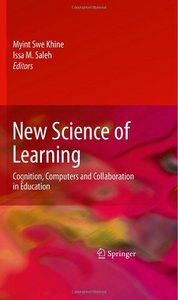 Zusammenfassungen
Zusammenfassungen
 The earliest educational software simply transferred print material from the page to the monitor. Since then, the Internet and other digital media have brought students an ever-expanding, low-cost knowledge base and the opportunity to interact with minds around the globe—while running the risk of shortening their attention spans, isolating them from interpersonal contact, and subjecting them to information overload.
The earliest educational software simply transferred print material from the page to the monitor. Since then, the Internet and other digital media have brought students an ever-expanding, low-cost knowledge base and the opportunity to interact with minds around the globe—while running the risk of shortening their attention spans, isolating them from interpersonal contact, and subjecting them to information overload.
The New Science of Learning: Cognition, Computers and Collaboration in Education deftly explores the multiple relationships found among these critical elements in students’ increasingly complex and multi-paced educational experience. Starting with instructors’ insights into the cognitive effects of digital media—a diverse range of viewpoints with little consensus—this cutting-edge resource acknowledges the double-edged potential inherent in computer-based education and its role in shaping students’ thinking capabilities. Accordingly, the emphasis is on strategies that maximize the strengths and compensate for the negative aspects of digital learning, including:
- Group cognition as a foundation for learning
- Metacognitive control of learning and remembering
- Higher education course development using open education resources
- Designing a technology-oriented teacher professional development model
- Supporting student collaboration with digital video tools
- Teaching and learning through social annotation practices
 Dieses Buch erwähnt ...
Dieses Buch erwähnt ...
 Personen KB IB clear | B. S. Bloom , Fernando Flores , Terry Winograd | ||||||||||||||||||
 Begriffe KB IB clear | cognitive load theory (CLT)
,  Computer Computer computer
, computer
,  Internet Internet internet
, internet
,  LehrerIn LehrerIn teacher
, teacher
,  Lernen Lernen learning
, learning
,  Problemlösefähigkeit Problemlösefähigkeit problem solving skills
, problem solving skills
,  Psychologie Psychologie psychology
, psychology
,  Software Software software
, software
,  Technologie Technologie technology
, technology
,  Turnitin Turnitin
| ||||||||||||||||||
 Bücher |
| ||||||||||||||||||
 Texte |
|
 Dieses Buch erwähnt vermutlich nicht ...
Dieses Buch erwähnt vermutlich nicht ... 
 Nicht erwähnte Begriffe | Bildung, Digitalisierung, Kinder, Schule, Unterricht |
 Tagcloud
Tagcloud
 Zitationsgraph
Zitationsgraph
 Zitationsgraph (Beta-Test mit vis.js)
Zitationsgraph (Beta-Test mit vis.js)
 7 Erwähnungen
7 Erwähnungen 
- Supporting orchestration of CSCL scenarios in web-based Distributed Learning Environments (Luis P. Prieto, Juan I. Asensio-Pérez, Juan A. Muñoz-Cristóbal, Iván M. Jorrín-Abellán, Yannis Dimitriadis, Eduardo Gómez-Sánchez)


- The Future of Educational Neuroscience (Kurt W. Fischer, Usha Goswami, John Geake, Task Force on the Future of Educational Neuroscience) (2010)


- Supporting Student Self-regulation in Unsupervised Learning Environments (Paul Salvador Inventado, Masayuki Numao) (2012)

- Research on e-Learning and ICT in Education (Athanassios Jimoyiannis) (2012)

- Technological Pedagogical Content Knowledge - Exploring, Developing, and Assessing TPCK (Charoula Angeli, Nicos Valanides) (2015)



- Cognitive Processes Underlying TPCK: Mental Models, Cognitive Transformation, and Meta-conceptual Awareness (Karsten Krauskopf, Carmen Zahn, Friedrich W. Hesse)



- Cognitive Processes Underlying TPCK: Mental Models, Cognitive Transformation, and Meta-conceptual Awareness (Karsten Krauskopf, Carmen Zahn, Friedrich W. Hesse)
- Second Handbook of Information Technology in Primary and Secondary Education (Joke Voogt, Gerald Knezek, Rhonda Christensen, Kwok-Wing Lai) (2018)


- 38. Formative Assessment and Feedback Using Information Technology (Fabienne van der Kleij, Lenore Adie)


- 38. Formative Assessment and Feedback Using Information Technology (Fabienne van der Kleij, Lenore Adie)
- Educational Technologies for Vocational Training - Experiences as Digital Clay (Pierre Dillenbourg, Alberto Cattaneo, Jean-Luc Gurtner, Richard Lee Davis) (2022)


 Volltext dieses Dokuments
Volltext dieses Dokuments
 Bibliographisches
Bibliographisches 
 Beat und dieses Buch
Beat und dieses Buch
Beat hat dieses Buch während seiner Zeit am Institut für Medien und Schule (IMS) ins Biblionetz aufgenommen. Beat besitzt kein physisches, aber ein digitales Exemplar. (das er aber aus Urheberrechtsgründen nicht einfach weitergeben darf). Es gibt bisher nur wenige Objekte im Biblionetz, die dieses Werk zitieren.











 , 6210 kByte)
, 6210 kByte) 



 Biblionetz-History
Biblionetz-History